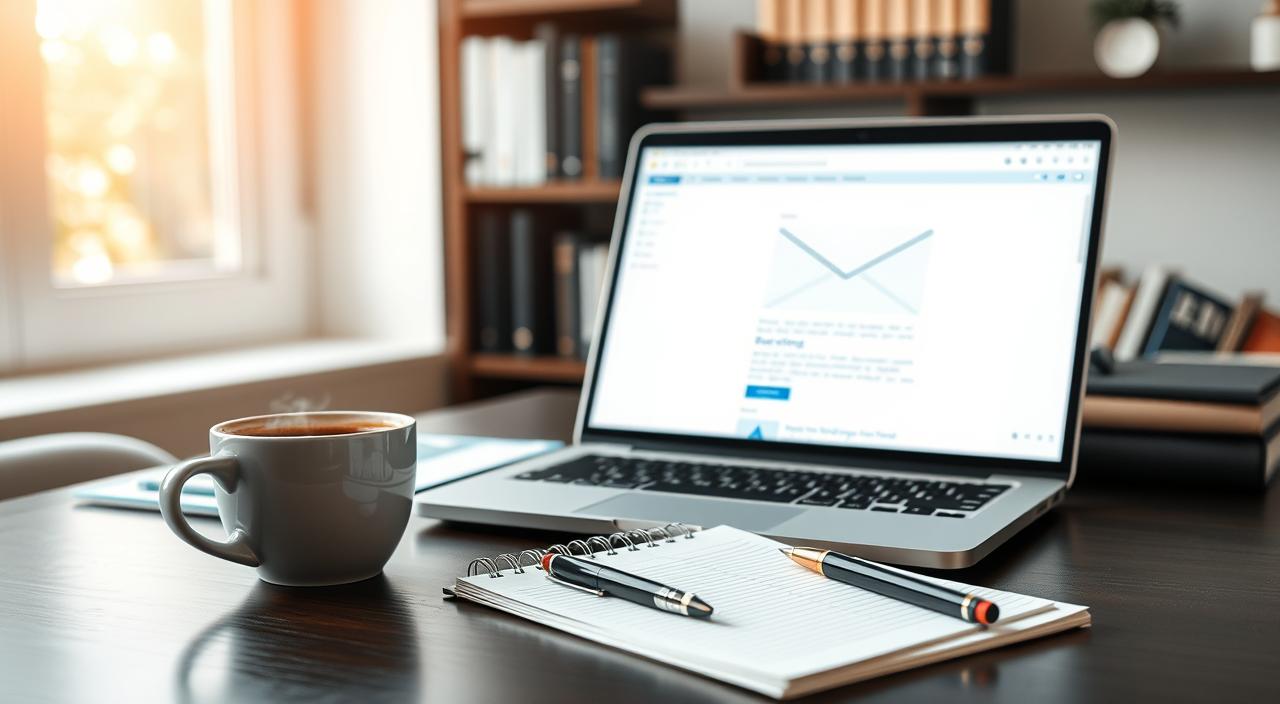Americans send hundreds of thousands of emails daily, making email etiquette vital for professional communication. A poorly written, unprofessional email can harm your reputation and damage business relationships. This guide will teach you the key dos and don’ts of email etiquette. It aims to enhance your email skills, ensuring you leave a positive impression on your recipients.
Key Takeaways
- Proper email etiquette represents both the individual and their brand.
- Quick, casual responses can negatively impact professional connections.
- Using appropriate salutations and maintaining a formal yet friendly tone is critical.
- Staying concise and proofreading emails can improve their effectiveness.
- Avoiding buzzwords, acronyms, and emotional outbursts promotes professionalism.
Crafting an Effective Email
Proper Salutation and Introduction
When crafting a professional email, it’s essential to begin with a proper email salutation and introduction. Steer clear of casual greetings like “hi” or “hey.” Instead, opt for more formal phrases such as “Good morning,” “Good afternoon,” or “Hello.” In your introduction, clearly state your name and provide some background information about yourself and the purpose of your email. This establishes your credibility and ensures the recipient understands the context of your communication.
Industry experts suggest that a good email subject line should convey the purpose of your email in 7-10 words. This clarity helps the recipient quickly grasp the topic, boosting the likelihood of your message being read and responded to promptly. Aim for emails that are concise, with 50-200 words being sufficient to convey your key points effectively.
Adhering to email etiquette is vital for creating a positive impression and fostering strong professional relationships. Responding to emails within 24 hours is advisable, as it shows your commitment to timely communication. Also, proofreading your emails carefully can help catch any typos or grammar errors, ensuring your message is polished and professional.
| Appropriate Email Salutations | Inappropriate Email Salutations |
|---|---|
| Dear [Recipient’s Name], Good morning/afternoon, Hello [Recipient’s Name], |
Hi, Hey there, Yo [Recipient’s Name], |
By adhering to these best practices for email etiquette, you can create effective and professional emails. These emails are instrumental in building strong relationships and facilitating successful business communication.
The Art of Concise Communication
Effective email communication is built on the foundation of conciseness and clarity. In today’s fast-paced business world, recipients value emails that are direct and to the point. A recent survey found that 75% of professionals prefer concise and relevant emails to save time. By following best practices for email writing, you can make your messages easy to understand and prompt action.
Proofreading and Tone
The presentation of your emails is just as important as the content. Thorough proofreading is key to avoid spelling and grammar errors, which can harm your professionalism. Also, 92% of professionals believe that using a professional tone is essential in business email communication.
Finding the right balance between formality and approachability is critical. Avoid humor, sarcasm, or overly casual language, as they can be misinterpreted. Instead, aim for a friendly yet polished style that shows clarity and confidence. With detailed proofreading and a well-crafted professional tone, your emails will be received as intended.
| Statistic | Percentage |
|---|---|
| Respondents who find maintaining a clear subject line essential for effective email communication | 80% |
| Professionals who believe that using a professional tone is critical in professional emails | 92% |
| Recipients who prefer concise and relevant emails to save time | 75% |
| Professionals who confirm that proofreading emails before sending is a sign of professionalism | 85% |
By focusing on concise communication, maintaining a professional tone, and thoroughly proofreading your emails, you can ensure your messages are clear and professional. This leads to more effective business email interactions.
“Concise and clear emails are the hallmark of an efficient and professional communicator.”
Email Etiquette: The Dos and Don’ts of Professional Emails
Mastering email etiquette is key for maintaining a polished and effective communication style. When crafting emails for business, several best practices are essential. Understanding the dos and don’ts of professional email etiquette ensures your messages are well-received. This contributes to a positive professional image.
One critical email etiquette tip is to use a clear, informative subject line. Studies show that subject lines over 6 words may end up in spam. So, keep your subject lines concise and relevant to the email’s purpose.
Another important email etiquette practice is to double-check attachments before sending. Forgetting an attachment or attaching the wrong file can be frustrating. It also reflects poorly on your professionalism.
- what struggles or victories have you experienced when it comes to saving money?
- DeAndre Hopkins: Elite NFL Wide Receiver
It’s also vital to reply in a timely manner. Aim to respond within 24 hours or less. This shows your commitment to effective communication and respect for your colleagues’ time.
On the other hand, there are several email etiquette practices to avoid. These include using too many exclamation marks, inappropriate humor or sarcasm, and forwarding emails without permission. These behaviors can appear unprofessional and hinder effective communication.
By adhering to these professional email etiquette guidelines, your emails will be well-received. This contributes to a positive professional image. Remember, attention to detail and adherence to best practices are vital for successful business communications.
“Effective and polite email communication is the foundation of successful professional interactions.” – Jane Doe, Communication Expert
Leveraging Cc and Bcc Effectively
In the world of professional emails, Cc and Bcc are powerful tools when used right. The Cc feature keeps others informed, but use it wisely to avoid inbox clutter. Bcc is great for privacy or discreetly sharing with a third party. Yet, it’s key to think about your email’s context and purpose before using these features. This ensures you’re not breaking confidentiality or misusing them.
When to Use Cc and Bcc
Using Cc and Bcc correctly can greatly enhance your email’s impact. Here are some tips:
- Use Cc to keep those who need to know updated, without needing a reply from them.
- Turn to Bcc for mass emails or company-wide messages to safeguard recipient privacy and hide email addresses.
- Be careful with Bcc, as it can stir up ethical and legal issues, mainly in sensitive or confidential emails.
Strategically applying Cc and Bcc can lead to clearer, more effective email communication at work.
| When to Use Cc | When to Use Bcc |
|---|---|
| Keep relevant parties informed without requiring a direct response | Protect the privacy of recipients in mass emails or company-wide announcements |
| Introduce or connect copied persons | Avoid exposing email addresses to all recipients |
| Inform the primary recipient that others are being informed | Use with caution, as Bcc can raise ethical and legal concerns in sensitive communication |
“The strategic use of Cc and Bcc can help you maintain clear, transparent, and effective email communication in your professional setting.”
Conclusion
Professional email etiquette is key to a positive brand image and effective business relationships. By following the best practices in this guide, you can improve your email communication. This makes you appear polished and competent. Every email reflects your professionalism, so make sure to send clear, concise, and courteous messages.
The key takeaways for professional email communication include descriptive subject lines and brevity. Also, proofread your emails and be cautious with “Reply All” and CC functions. Adhering to these email etiquette rules can improve email etiquette and boost your business communication. Investing in email etiquette training for your team is also beneficial. It strengthens the importance of email etiquette in business and maximizes its benefits.
Effective email communication is vital for professional interactions. Mastering email etiquette can distinguish you, build stronger relationships, and contribute to a positive communication culture in your organization.
FAQ
What is the importance of professional email etiquette?
Professional email etiquette is vital for projecting a positive image of yourself and your brand. A poorly crafted email can damage your professional reputation. It can also harm your business relationships.
How should I start a professional email?
Steer clear of casual greetings like “hi” or “hey.” Opt for more formal options like “Good morning,” “Good afternoon,” or “Hello.” Begin by stating your name and a brief introduction. This should include your purpose for emailing.
What are the best practices for email content and tone?
Keep your emails brief and focused. Always proofread to catch any spelling or grammar mistakes. Aim for a tone that is both friendly and formal. This approach helps convey professionalism and clarity. Refrain from using humor, sarcasm, or overly casual language.
What are the dos and don’ts of professional email etiquette?
Best practices include crafting a clear subject line and double-checking attachments. Also, respond promptly to emails. Avoid using too many exclamation marks, humor, or sarcasm. Never forward emails without permission.
When should I use the Cc and Bcc features in email?
The Cc feature is for keeping others informed, but use it sparingly to prevent inbox clutter. The Bcc is useful for privacy or discreet notifications. Before using these features, consider the context and purpose of your email.

My name is Jakir, I am a content writer, content creator, I give business, sports, finance, trending news and I have 10 years of experience in this and this is my blog goldennews24.com.










